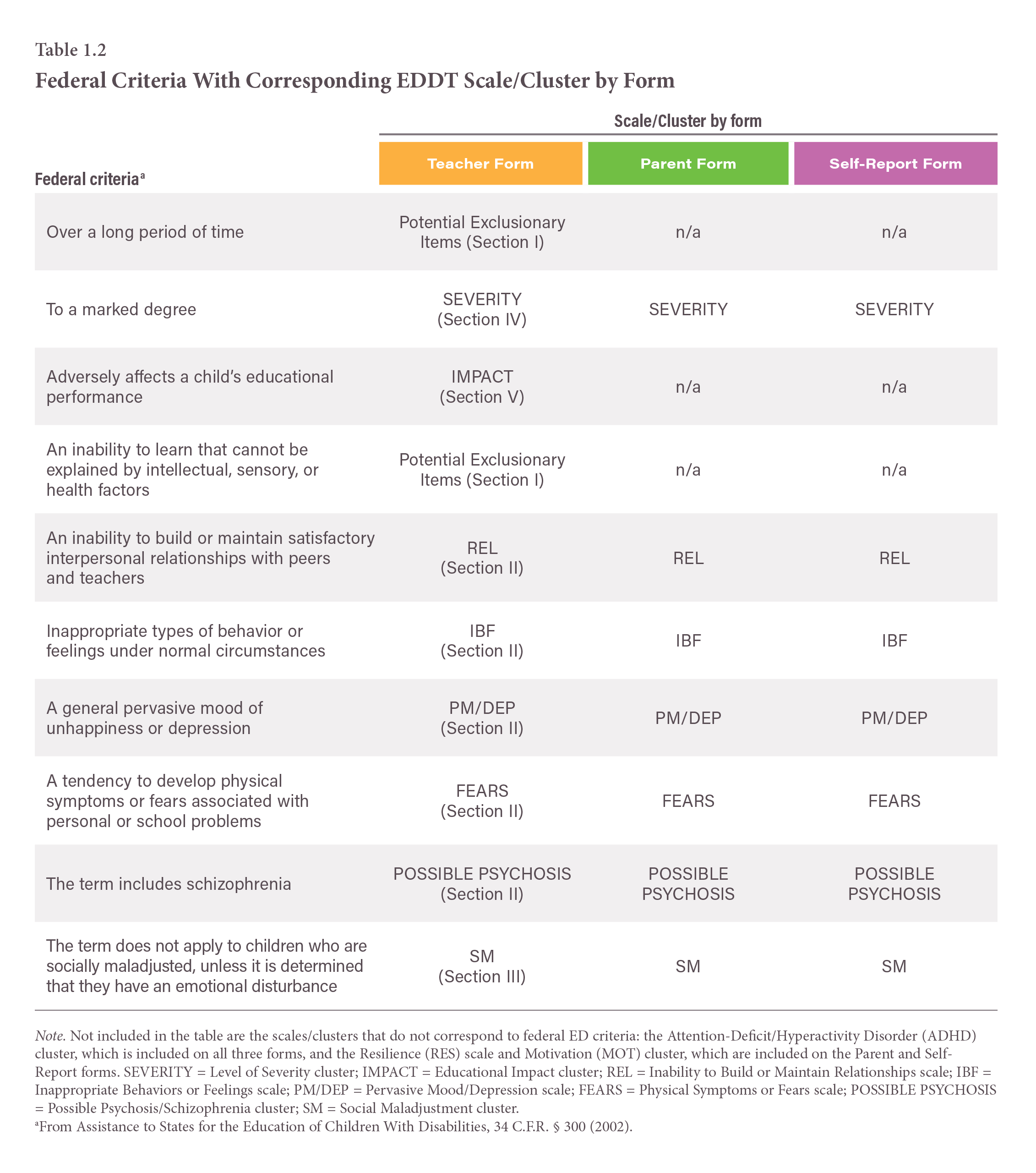Register now and start:
- Accessing PAR Training
- Shopping PAR products & tools
- Using online assessments with PARiConnect
The EDDT helps you determine qualification for special education services under the category of emotional disturbance by assessing from the teacher, parent, and students’ perspectives. It is the first instrument of its kind to provide a standardized approach to the assessment of emotional disturbance (ED). It is a standardized, norm-referenced assessment designed to assist in the identification of children who qualify for the federal special education category of ED. The EDDT addresses the broad emotional and behavioral nuances of children who may require special education services for ED.
The EDDT materials have been completely redesigned and streamlined to make your assessment experience easier.
If you already own these printed EDDT materials, you may keep using them until it’s time to purchase more.
For future orders, the Response Booklet (answer sheet) and the Item Booklet will be replaced by the applicable printed form (Teacher, Parent, Self-Report, Parent Self-Report, Spanish Self-Report) plus a Score Report. The Multirater Summary Report, available for free, can be used to review results from multiple raters. For those with existing forms who need additional Score Reports, contact Customer Support.
In August 2024, the EDDT materials were streamlined to make your assessment experience easier, with all three forms (Parent, Teacher, and Self-Report) being addressed in one manual and a single i-Admin/Score Report. Your existing digital inventory was automatically moved at launch.
Specifically, all unused inventory for the five EDDT i-Admins (Teacher: 10518-IC, Parent: 10520-IC, Spanish Parent: 12030-IC, Self-Report: 11434-IC, Spanish Self-Report: 12031-IC) was moved to a single new i-Admin item number, and all unused inventory for the three Score Reports (Teacher: 10519-IS, Parent: 10521-IS, Self-Report: 11435-IS) was moved to a single new Score Report item number. For future orders, purchase the EDDT i-Admin/Score Report (12270-IK).
Previously generated reports and exports are still available and able to be regenerated. In-progress i-Admins, manual entry forms, and unscored reports are unaffected.
To see your inventory, log into PARiConnect and select View Inventory. Your screen will look like this:
![]()
here are a number of enhancements to help streamline your administration. Going forward you purchase an i-Admin/Score Report bundle. Once you are logged into PARiConnect, you then choose which form to administer and which report to generate. The Multirater Summary Report remains free and is generated after at least two score reports have been generated for the same individual. All scoring is now done on PARiConnect. No more hand scoring.
Here is how you select which form to administer in PARiConnect.
![]()
Norms are based on a sample of 601 children who were demographically matched to U.S. Census statistics. Data were also collected on a sample of 404 children eligible for special education due to an ED diagnosis.
Internal consistency was high (r = .94) for the EDDT Total Score and ranged from .75 to .88 for the scales. In addition, test-retest stability was high (r = .92) and interrater reliability was good (r = .84) for the EDDT Total Score.
Convergent validity was examined using the CAB Teacher and Parent Forms, the BASC-2 Teacher Form, and the Teacher Report Form of the CBCL. Validity also was examined in populations of children with specific learning disabilities, speech/language impairment, mental retardation, ADHD, autism spectrum disorder, and social maladjustment.
The normative sample of 889 children was well matched to U.S. Census statistics. In addition, data were collected on a sample of 430 children eligible for special education due to an ED diagnosis.
Internal consistency was high for scales (median r = .81) and clusters (median r = .91), test-retest reliability was high for scales (median r = .95) and clusters (median r = .96), and interrater reliability was good (r = .87) for the total score.
Convergent validity was examined with the BASC 2 PRS, Conners Parent Scale, CDS, DTCEP, and PBRS. Validity was also examined among children with various special education needs, ADHD, social maladjustment, and psychosis.
The normative sample of 614 children and adolescents was well matched to U.S. Census statistics. In addition, data were collected from 162 children with an ED diagnosis.
Internal consistency and test-retest reliability was high for the scales and clusters. Interrater reliability was good for the total score.
Convergent validity was examined with the BASC-2 SRP. Validity samples were collected with four groups of children representing various special education exceptionalities, including specific learning disabilities, ADHD, psychosis, and social maladjustment.

The Multirater Summary Report, available for free after at least two score reports have been generated for one individual, can be used to review results from multiple raters to create a well-rounded picture of an individual's functioning. It includes a combined score profile to represent similarities and differences between raters graphically and highlights statistically significant score differences. The EDDT Criteria Table aligns each rater’s scores to the federal criteria for ED diagnosis. A sample report is available in the Resources section.
Yes, the EDDT will help you assess all the areas needed to determine if the student meets the federal eligibility for ED.
The EDDT helps the clinician work through the federal criteria for eligibility for ED in an organized manner. The Possible Psychosis cluster of items screens for common possible psychotic/schizophrenic features but is NOT diagnostic of psychosis or schizophrenia. The clinician may choose to include a recommendation to consider additional evaluation.